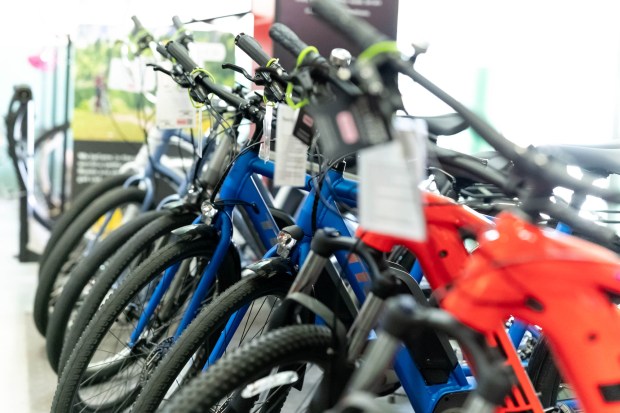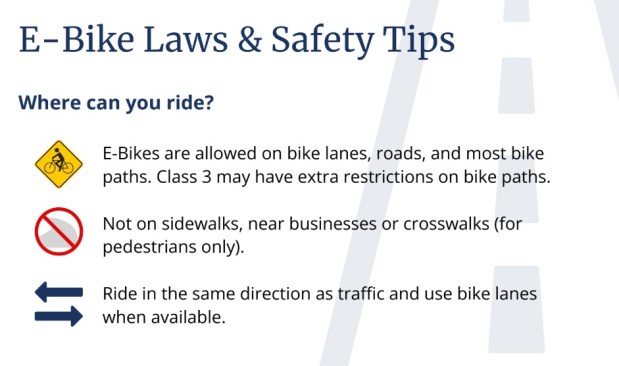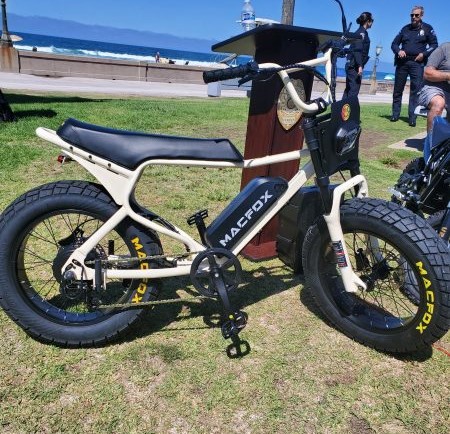This is the second part of a series exploring electric bicycles, their local impact and the ongoing controversy that surrounds them.
While the popularity of e-bikes grew in San Diego County in recent years, not everyone was ready for it. That includes legislators, parents, schools, motorists and pedestrians.
Charged Up: The Rise of E-bikes, series Part 1: Roots of a controversy
So how have e-bike riders — an increasing number of whom are younger than 18 — been educated on the dos and don’ts of using them, and is it enough?
The La Jolla Light looked at the appeal of e-bike ridership and how education and regulation have been handled thus far.
Growing attraction
Though specialized e-bike shops have been in operation for more than a decade, their recent explosion in business can be attributed to changes in offerings and price.
According to market research group Circana, e-bikes accounted for 63% of the growth in all bicycle sales in the United States between 2019 and 2023, and they made up around 30% of overall market share in the U.S. in 2024, according to People for Bikes.
Also, about 450,000 e-bikes were sold on brand websites in 2024 for $850 million, effectively doubling previously known U.S. e-bike sales, People for Bikes reported.
 Electric bicycles await potential buyers. (David Crane / Los Angeles Daily News)
Electric bicycles await potential buyers. (David Crane / Los Angeles Daily News)
According to Global Market Insights, the U.S. e-bike market is expected to grow from $2.3 billion this year to $4.5 billion in 2034. California dominated the western U.S. e-bike market with about 53% of the share and $528.8 million in revenue in 2024.
“Companies evolved in ways that one-upped last year’s product and improved them,” said San Diego Police Department Officer Dustin Welsh. “And when more companies were producing more variety and when the prices came down, you started seeing more markets and more brands. That’s when we noticed an increase in what we are seeing on the street.”
The average price of an e-bike dropped from about $2,100 in 2020 to approximately $1,700 in 2023, though prices can range from around $800 to $6,000, according to Tesway Bike.
E-bikes offer riders an opportunity to use something other than a car or public transportation to get around, which also has boosted their popularity, according to Colin Parent, chief executive of Circulate San Diego, a nonprofit that partners with local governments, school districts, private planning firms and other organizations in an effort to create more mobility choices.
Though e-bikes initially were most popular among older adults, they are increasingly used by teenagers and young adults.
“There’s just a lot of advantages,” Parent said. “They’re an attractive mode [of transportation] for a lot of people. A lot of times, people who are not confident bicyclists, or because they don’t have the same sort of strength and agility as some do, feel very confident on an e-bike because there’s some assistance.”
Electric bikes, which are rechargeable, lack emissions and can reach speeds of 20 to 28 mph, are equipped with a motor that provides assistance when the rider is pedaling. Some have a motor with a throttle that can power the bike without pedaling.
“For the kids we talk to, they mention how it’s convenient in that they can hang out with their friends or whatever they set out to do faster,” Welsh said.
In addition, the California E-Bike Incentive Project provides income-qualified residents with up to $2,000 to support the purchase of a new electric bike. The program, intended as a way to fight climate change, officially launched in December 2024 with the first round of 1,500 vouchers.
But the project, funded by the California Air Resources Board, has been fraught with setbacks and allegations against Pedal Ahead, a San Diego-based nonprofit chosen to administer it.
A second round of applications this spring for the e-bike incentive was delayed amid further problems.
Safety is ‘hot topic’
The rising use of electric bicycles, especially among younger riders, has increased concerns about safety.
Doctors are seeing a surge in e-bike-related injuries, according to research published in April by Children’s Hospital Orange County, which said such injuries tend to be “more severe compared to manual bikes due to the speed and lack of operator skill.”
Dr. John Schlechter, a pediatric orthopedic surgeon at CHOC, said in an article accompanying the research that complex patella (knee) fractures that were once rare in children are becoming much more common among young e-bike riders.
“E-bike injuries just blow the kneecap apart because it’s that high-velocity, high-energy impact that we really don’t see in [manual] bicycle falls,” Schlechter said. “We’re putting implants in children that I’ve never seen put on a 13-year-old knee.”
With e-bike ridership getting younger, unsafe behavior has become a chronic problem, according to San Diego police.
“There are daily calls … department-wide,” including in La Jolla, Welsh said.
The reports come via phone, email and the city of San Diego’s Get It Done app.
“Someone will be at home and see kids just tearing up the street,” Welsh said. “The department posts on social media regularly to educate riders and provide information about incidents and how they can lead to life-changing consequences.”
“We’re cracking down on everyone,” he added. “This is our hot topic.”
E-bike safety has been the subject of multiple discussions in La Jolla in recent years.
In September 2023, a 14-year-old Muirlands Middle School student was riding his electric bike to school in a marked bike lane when he and a car collided amid heavy traffic. The student suffered broken bones in a hand and foot.
During a Town Council public safety forum that month, discussions led to a vote to submit a letter to city officials asking for stronger regulations on e-bikes, “similar to what you would have with other forms of [motorized] transportation.”
At a La Jolla Parks & Beaches meeting in January 2024, several board members and others echoed the need for more regulations.
“It’s very sad to see teenagers that totally disregard the rules of the road on their e-bikes,” board member Alexandra Corsi said at the time. “It is a motorized vehicle.”
“Teenagers are going to be teenagers and do what they are going to do, but we as a community need to somehow convey the message that it is very dangerous for both drivers and the riders,” Corsi said. “It’s getting really dangerous and there is going to be an accident. The person driving [a car], the one with a driver’s license, is going to be held responsible for a teenager that doesn’t have a license.”
In addition, because electric bikes use lithium-ion batteries that can cause severe fires when they malfunction, firefighters caution riders to:
• Buy an electric bike that is certified by a qualified testing organization such as Underwriters Laboratory.
• Follow the manufacturer’s instructions for charging and storage.
• Do not leave an electric bike unattended while it’s charging, and don’t leave it charging overnight. Do not put the e-bike in the way of your primary path into and out of a building.
• Keep batteries at room temperature; do not place them in direct sunlight. Store batteries away from anything flammable.
• Dispose of used batteries and chargers at a designated battery recycling center. Don’t throw them in the trash.
Despite all the concerns, Harry Bubbins, a board member of the La Jolla Community Planning Association and an organizer for Respect Bird Rock — a local advocacy group pushing for lower speed limits on La Jolla Boulevard — said the e-bike safety debate is “confused,” contending that complaints mostly center on high-speed electric motorcycles and not pedal-assist e-bikes that give “kids freedom, exercise and fresh air.”
Electric motorcycles — also known as e-dirt bikes or e-motos — have top speeds ranging from 15 to 50 mph or more. They are legal only for off-road use and are distinct from e-bikes in that there are no pedals on e-motorcycles.
Bubbins believes the benefits of e-bikes outweigh any challenges. He described them as “a revolutionary upgrade” to regular bicycles and said they replace car trips with exercise and time outdoors.
He argues that the real safety problem is in road design and car speeds.
“We’re having the wrong safety debate,” Bubbins said. “The real danger is the constant speeding and crashes on our main roads like La Jolla Boulevard or Nautilus [Street], not students on bikes.
“Our car-centric street design is the root problem, not e-bike technology. We’re trying to solve a 21st-century issue with a 20th-century street plan.”
Education and outreach
Circulate San Diego sees following the rules of the road and driving responsibly as fundamental guidelines for users of all bicycles.
That includes using hand signals, riding defensively and mitigating risks, Parent said.
“Broadly our approach … is, whether a bike has an electric component or not, it’s still a bicycle,” he said. “The rules of the road, the best practices, the ways to keep safe apply to both an e-bike and a non-e-bike.”
“They are vulnerable on the streets compared to motorists,” Parent continued. “Even a bicycle with a motor doesn’t have several tons of metal protecting the bicyclist. And the e-bike and non-e-bike both have to coexist with automobiles in the right of way. That can be equally dangerous for people operating the bicycle.”
Without proper education, Welsh said, many e-bike riders “treat it like a bicycle instead of a motorized vehicle.”
“Officers would make fliers outlining the dos and don’ts and were passing them out in schools,” Welsh said. “We also did an email blast to parents that the schools and school police were involved, so even if a parent has no interest in getting their child an e-bike, they can read it.”
 A flier distributed by the San Diego Police Department outlines some of the dos and don’ts of e-bike ridership. (SDPD)
A flier distributed by the San Diego Police Department outlines some of the dos and don’ts of e-bike ridership. (SDPD)
Officers also held public seminars about bike safety but stopped because of low attendance, Welsh said. “Parents and kids are busy, so they are not going to come and sit in and listen,” he said.
A 13-year-old e-bike rider from La Jolla, whose name is being withheld at his parents’ request, said he was unable to attend such a meeting because of a schedule conflict and did not receive any informational material before or immediately after getting his e-bike.
“The police let me know you can’t go over 20 mph [under California law, no one younger than 16 is allowed to ride a Class 3 e-bike, which can travel up to 28 mph], and my parents said you can’t have anyone on the back of it, and I know the school doesn’t allow bikes without pedals,” the boy said when asked about the extent of his e-bike education.
Legislative response
To address e-bike issues, state Assemblywoman Tasha Boerner (D-Encinitas), whose 77th District includes La Jolla, introduced a bill in February 2024 intended to require would-be riders without a valid driver’s license (i.e., those younger than 16 or who haven’t taken driver education courses) to take an online e-bike safety training course, complete a written test and receive a “license” (state-issued photo ID) to operate an e-bike.
However, various departments weighed in and found the proposal to be overly expensive and labor-intensive.
The bill, AB 2234, was amended to focus on a city-by-city opt-in pilot program prohibiting children younger than 12 from operating e-bikes.
AB 2234 was signed by Gov. Gavin Newsom in September 2024.
“E-bikes are an amazing way for our kids to get around, but they need to be at an age where they can ride defensively and correctly navigate through large streets, intersections, cars and pedestrians,” Boerner stated at the time. “The data shows that kids on e-bikes under 12 have the greatest number of accidents and risk of severe injuries.”
A driver’s license, license plate, insurance and registration still are not required for e-bikes.
A second bill that Boerner introduced last year would create a digital handbook including the rules of the road and e-bike regulations in one place.
Next installment
The next article in this series will explore how other locales outside San Diego are dealing with e-bike issues. ♦
